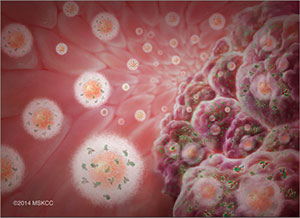


Posted November 6, 2014
Jan Grimm, M.D., Ph.D., Memorial Sloan-Kettering Cancer Center
 Many novel therapeutics for prostate cancer (PCa) never reach the clinic because they are not efficiently delivered and localized to the area targeted for treatment. Poor drug delivery and localization reduces the agent's efficacy for modulating cellular responses, which in turn requires higher doses that can increase the likelihood of adverse and toxic effects on noncancerous tissue. The development of an alternative method to deliver one or several agents in a specific, controlled manner to PCa cells would be a useful tool to improve the efficiency of treatments and alleviate the suffering of afflicted men. With support from a fiscal year 2011 PCRP Idea Development Award, Dr. Jan Grimm of the Memorial Sloan-Kettering Cancer Center is producing nanoparticle vehicles to improve drug delivery and halt cancer growth.
Many novel therapeutics for prostate cancer (PCa) never reach the clinic because they are not efficiently delivered and localized to the area targeted for treatment. Poor drug delivery and localization reduces the agent's efficacy for modulating cellular responses, which in turn requires higher doses that can increase the likelihood of adverse and toxic effects on noncancerous tissue. The development of an alternative method to deliver one or several agents in a specific, controlled manner to PCa cells would be a useful tool to improve the efficiency of treatments and alleviate the suffering of afflicted men. With support from a fiscal year 2011 PCRP Idea Development Award, Dr. Jan Grimm of the Memorial Sloan-Kettering Cancer Center is producing nanoparticle vehicles to improve drug delivery and halt cancer growth.
From the outset, Dr. Grimm was investigating the adaptation of already clinically approved nanoparticles (microscopic iron oxide crystals encapsulated in a polymer coating) for recognition of an antigen on PCa cells that correlates with the aggressiveness of the cancer (prostate-specific membrane antigen; PSMA). His initial goal was to utilize the properties of these nanoparticles to improve detection and diagnostic methods. Upon preparation it was observed that these particles not only specifically recognized tumor cells, but were also easily loaded with drug molecules, which allows therapy functionality of the native unmodified particles. With the dual functionality of both a therapeutic vehicle and diagnostic agent, these molecules are referred to as theranostic agents. A distinctive feature of the diagnostic aspect of the particle is that it not only helps in cancer detection but, using the relaxation properties of the nanoparticles, can monitor the drug release process using a standard MRI device. This attribute allows physicians to determine when and where drugs are released with equipment readily available in the clinic.
Dr. Grimm continues to advance the pre-clinical development of these particles, and is communicating with his institution and other industrial partners to help move these agents to the clinic. Both the nanoparticle base (currently used to treat iron deficiency) and the drugs that will be loaded into the particles are already in clinical testing or in regular use in the clinic, which should expedite approvals for future clinical trials. The MRI equipment for detection of the nanoparticle is also currently available at most major hospitals, which will allow for broad application of drug delivery monitoring by physicians.

Links:














